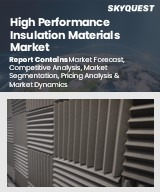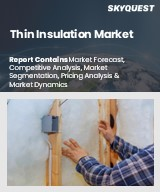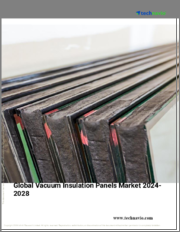
|
시장보고서
상품코드
1683599
세계의 진공 단열 패널 시장 조사 보고서 : 산업 분석, 규모, 점유율, 성장, 동향 및 예측(2025-2033년)Global Vacuum Insulation Panels Market Research Report- Industry Analysis, Size, Share, Growth, Trends and Forecast 2025 to 2033 |
||||||
세계의 진공 단열 패널 시장 규모는 2024년 96억 8,000만 달러에서 2033년에는 153억 8,000만 달러에 달하고, 2026-2033년의 예측 기간 동안 5.28%의 견고한 연평균 성장률(CAGR)을 보일 것으로 예상됩니다.
VIP는 기존 단열재에 비해 열전도를 크게 감소시키는 우수한 단열 특성으로 유명하며, 건설 및 냉동 부문에서 에너지 효율적인 단열 솔루션에 대한 수요가 증가함에 따라 세계 진공 단열 패널(VIP) 시장이 크게 성장할 것으로 예상됩니다. 건물 설계 및 소비자 전자제품 제조에 있어 에너지 효율이 우선순위가 되면서 진공 단열 패널의 채택이 크게 증가하여 이 시장에 대한 혁신과 투자를 촉진할 것으로 예상됩니다.
또한, VIP 제조 기술 및 재료의 발전은 진공 단열 패널 시장을 더욱 촉진할 것으로 예상됩니다. 새로운 배리어 소재의 개발과 제조 공정의 개선으로 VIP의 내구성과 성능이 향상되어 보다 다양한 용도에 적합하게 되었습니다. 또한, 지속가능성과 탄소 발자국 감소에 대한 관심이 높아지면서 에너지 절약과 환경 보호에 기여하는 단열 솔루션에 대한 수요가 증가하고 있습니다. 점점 더 많은 제조업체들이 에너지 효율 목표를 달성하기 위해 고품질 진공 단열 패널의 중요성을 인식함에 따라, 시장은 다양한 용도의 요구를 충족하는 혁신적인 솔루션에 대한 수요가 급증할 것으로 예상됩니다.
또한, 규제 준수와 건축법에 대한 관심이 높아짐에 따라 진공 단열 패널 시장의 미래가 형성될 것으로 예상됩니다. 각국 정부가 에너지 효율 및 건축 성능에 대한 규제를 강화함에 따라 이러한 기준을 충족하는 VIP에 대한 수요는 계속 증가할 것으로 예상되며, VIP 제조업체, 건축가 및 규제 기관 간의 협력은 이러한 발전을 촉진하는 데 필수적이며, 진공 단열 패널 시장이 건설 및 냉동 산업의 진화하는 요구에 부응할 수 있도록 보장합니다. 진공 단열 패널 시장이 건설 및 냉동 산업의 진화하는 요구에 계속 대응할 수 있도록 보장합니다.
본 보고서는 고객에게 다양한 산업 및 시장에 대한 종합적이고 실용적인 통찰력을 제공할 수 있도록 세심하게 작성되었습니다. 각 보고서는 시장 상황을 완전히 이해하기 위해 몇 가지 중요한 요소를 포함하고 있습니다.
시장 개요: 시장 개요: 정의, 분류, 산업 현황에 대한 개요 등 시장에 대한 자세한 소개.
시장 성장 촉진요인 : 시장 성장에 영향을 미치는 주요 촉진요인, 억제요인, 시장 성장 촉진요인 및 과제를 상세하게 분석합니다. 이 섹션에서는 기술 발전, 규제 변화, 새로운 트렌드 등의 요인을 검토합니다.
세분화 분석 : 제품 유형, 용도, 최종 사용자, 지역 등의 기준에 따라 시장을 명확한 부문으로 분류합니다. 이 분석을 통해 각 부문의 성과와 잠재력을 파악할 수 있습니다.
경쟁 구도 : 시장 점유율, 제품 포트폴리오, 전략적 이니셔티브, 재무실적 등 주요 시장 진입기업에 대한 종합적인 평가. 주요 기업들이 채택하고 있는 경쟁 역학 및 주요 전략에 대한 고찰이 포함되어 있습니다.
시장 예측 : 과거 데이터와 현재 시장 상황을 바탕으로 일정 기간 동안 시장 규모와 성장 추세를 예측합니다. 여기에는 정량적 분석과 미래 시장 궤적을 나타내는 그래프 표시가 포함됩니다.
지역 분석 : 지역별 시장 성과를 평가하고 주요 시장 및 지역 동향을 파악할 수 있습니다. 지역 시장 역학 및 비즈니스 기회를 이해하는 데 도움이 됩니다.
새로운 트렌드와 기회 : 현재 시장 동향과 새로운 시장 동향, 기술 혁신, 잠재적 투자 대상 부문을 식별합니다. 미래 시장 개척 및 성장 전망에 대한 통찰력을 제공합니다.
목차
제1장 서문
제2장 주요 요약
- 시장 하이라이트
- 세계 시장 현황
제3장 진공 단열 패널 산업 분석
- 서론 - 시장 역학
- 시장 성장 촉진요인
- 시장 성장 억제요인
- 시장 기회
- 산업 동향
- Porter의 Five Forces 분석
- 시장의 매력 분석
제4장 밸류체인 분석
- 밸류체인 분석
- 원료 분석
- 원료 리스트
- 원료 제조업체 리스트
- 주요 원료 가격 동향
- 잠재적 바이어 리스트
- 마케팅 채널
- 직접 마케팅
- 간접 마케팅
- 마케팅 채널 발전 동향
제5장 세계의 진공 단열 패널 시장 분석 : 원료 유형별
- 원료 유형별 개요
- 원료 유형별 과거 및 예측 데이터 분석
- 플라스틱
- 금속
- 기타
제6장 세계의 진공 단열 패널 시장 분석 : 최종사용자별
- 최종사용자별 개요
- 최종사용자별 과거 및 예측 데이터 분석
- 의약품
- 식품
- 건설
- 기타
제7장 세계의 진공 단열 패널 시장 분석 : 형태 유형별
- 형태 유형별 개요
- 형태 유형별 과거 및 예측 데이터 분석
- 평면
- 구형
제8장 세계의 진공 단열 패널 시장 분석 : 코어 유형별
- 코어 유형별 개요
- 코어 유형별 과거 및 예측 데이터 분석
- 실리카
- 유리섬유
- 기타
제9장 세계의 진공 단열 패널 시장 분석 : 지역별
- 지역별 전망
- 서론
- 북미의 판매 분석
- 개요, 분석과 예측
- 북미 : 부문별
- 북미 : 국가별
- 미국
- 캐나다
- 멕시코
- 유럽의 판매 분석
- 개요, 분석과 예측
- 유럽 : 부문별
- 유럽 : 국가별
- 영국
- 프랑스
- 독일
- 이탈리아
- 러시아
- 기타 유럽
- 아시아태평양의 판매 분석
- 개요, 분석과 예측
- 아시아태평양 : 부문별
- 아시아태평양 : 국가별
- 중국
- 인도
- 일본
- 한국
- 호주
- 동남아시아
- 기타 아시아태평양
- 라틴아메리카의 판매 분석
- 개요, 분석과 예측
- 라틴아메리카 : 부문별
- 라틴아메리카 : 국가별
- 브라질
- 아르헨티나
- 페루
- 칠레
- 기타 라틴아메리카
- 중동 및 아프리카의 판매 분석
- 개요, 분석과 예측
- 중동 및 아프리카 : 부문별
- 중동 및 아프리카 : 국가별 리스트
- 사우디아라비아
- 아랍에미리트(UAE)
- 이스라엘
- 남아프리카공화국
- 기타 중동 및 아프리카
제10장 진공 단열 패널 기업 경쟁 구도
- 진공 단열 패널 시장 경쟁
- 제휴/협력/합의
- 인수합병(M&A)
- 신제품 발매
- 기타 개발
제11장 기업 개요
- 주요 기업의 시장 점유율 분석
- 시장 집중도
- Evonik Industries AG
- Dow
- Sonoco Products Company
- LX Hausys
- Panasonic Life Solutions
- Sealed Air
- Va QTec AG
- Cold Chain Technologies
- Cryopak
- Pelican BioThermal Limited
- American Aerogel
- Sofrigram SA Ltd
Global Vacuum Insulation Panels Market size is anticipated to grow from USD 9.68 Billion in 2024 to USD 15.38 Billion by 2033, showcasing a robust Compound Annual Growth Rate (CAGR) of 5.28% during the forecast period of 2026 to 2033.
The global vacuum insulation panels (VIPs) market is set to experience substantial growth, driven by the increasing demand for energy-efficient insulation solutions in the construction and refrigeration sectors. VIPs are known for their superior thermal insulation properties, which significantly reduce heat transfer compared to traditional insulation materials. As energy efficiency becomes a priority in building design and appliance manufacturing, the adoption of vacuum insulation panels is expected to rise significantly, fostering innovation and investment in this market.
Moreover, advancements in VIP manufacturing technologies and materials are anticipated to further boost the vacuum insulation panels market. The development of new barrier materials and improved manufacturing processes is enhancing the durability and performance of VIPs, making them more suitable for a wider range of applications. Additionally, the growing emphasis on sustainability and reducing carbon footprints is driving the demand for insulation solutions that contribute to energy savings and environmental conservation. As manufacturers increasingly recognize the importance of high-quality vacuum insulation panels in achieving energy efficiency goals, the market is likely to witness a surge in demand for innovative solutions that cater to diverse application needs.
In addition, the increasing focus on regulatory compliance and building codes is expected to shape the future of the vacuum insulation panels market. As governments implement stricter regulations regarding energy efficiency and building performance, the demand for VIPs that meet these standards will continue to rise. Collaborative efforts between VIP manufacturers, architects, and regulatory bodies will be essential in driving these advancements, ensuring that the vacuum insulation panels market remains responsive to the evolving needs of the construction and refrigeration industries.
Our reports are meticulously crafted to provide clients with comprehensive and actionable insights into various industries and markets. Each report encompasses several critical components to ensure a thorough understanding of the market landscape:
Market Overview: A detailed introduction to the market, including definitions, classifications, and an overview of the industry's current state.
Market Dynamics: In-depth analysis of key drivers, restraints, opportunities, and challenges influencing market growth. This section examines factors such as technological advancements, regulatory changes, and emerging trends.
Segmentation Analysis: Breakdown of the market into distinct segments based on criteria like product type, application, end-user, and geography. This analysis highlights the performance and potential of each segment.
Competitive Landscape: Comprehensive assessment of major market players, including their market share, product portfolio, strategic initiatives, and financial performance. This section provides insights into the competitive dynamics and key strategies adopted by leading companies.
Market Forecast: Projections of market size and growth trends over a specified period, based on historical data and current market conditions. This includes quantitative analyses and graphical representations to illustrate future market trajectories.
Regional Analysis: Evaluation of market performance across different geographical regions, identifying key markets and regional trends. This helps in understanding regional market dynamics and opportunities.
Emerging Trends and Opportunities: Identification of current and emerging market trends, technological innovations, and potential areas for investment. This section offers insights into future market developments and growth prospects.
SEGMENTATION COVERED IN THE REPORT
By Raw Material Type
- Plastic
- Metal
- Others
By End-user
- Pharmaceutical
- Food
- Construction
- Others
By Shape Type
- Flat
- Spherical
By Core Type
- Silica
- Fiberglass
- Others
- COMPANIES PROFILED
- Evonik Industries AG
- Dow
- Sonoco Products Company
- LX Hausys
- Panasonic Life Solutions
- Sealed Air
- Va QTec AG
- Cold Chain Technologies
- Cryopak
- Pelican BioThermal Limited
- American Aerogel
- Sofrigram SA Ltd.
- The above list can be customized.
TABLE OF CONTENTS
1. PREFACE
- 1.1. Report Description
- 1.1.1 Objective
- 1.1.2 Target Audience
- 1.1.3 Unique Selling Proposition (USP) & offerings
- 1.2. Research Scope
- 1.3. Research Methodology
- 1.3.1 Market Research Process
- 1.3.2 Market Research Methodology
2. EXECUTIVE SUMMARY
- 2.1. Highlights of Market
- 2.2. Global Market Snapshot
3. VACUUM INSULATION PANELS INDUSTRY ANALYSIS
- 3.1. Introduction - Market Dynamics
- 3.2. Market Drivers
- 3.3. Market Restraints
- 3.4. Opportunities
- 3.5. Industry Trends
- 3.6. Porter's Five Force Analysis
- 3.7. Market Attractiveness Analysis
- 3.7.1 Market Attractiveness Analysis By Raw Material Type
- 3.7.2 Market Attractiveness Analysis By End-user
- 3.7.3 Market Attractiveness Analysis By Shape Type
- 3.7.4 Market Attractiveness Analysis By Core Type
- 3.7.5 Market Attractiveness Analysis By Region
4. VALUE CHAIN ANALYSIS
- 4.1. Value Chain Analysis
- 4.2. Raw Material Analysis
- 4.2.1 List of Raw Materials
- 4.2.2 Raw Material Manufactures List
- 4.2.3 Price Trend of Key Raw Materials
- 4.3. List of Potential Buyers
- 4.4. Marketing Channel
- 4.4.1 Direct Marketing
- 4.4.2 Indirect Marketing
- 4.4.3 Marketing Channel Development Trend
5. GLOBAL VACUUM INSULATION PANELS MARKET ANALYSIS BY RAW MATERIAL TYPE
- 5.1. Overview By Raw Material Type
- 5.2. Historical and Forecast Data Analysis By Raw Material Type
- 5.3. Plastic Historic and Forecast Sales By Regions
- 5.4. Metal Historic and Forecast Sales By Regions
- 5.5. Others Historic and Forecast Sales By Regions
6. GLOBAL VACUUM INSULATION PANELS MARKET ANALYSIS BY END-USER
- 6.1. Overview By End-user
- 6.2. Historical and Forecast Data Analysis By End-user
- 6.3. Pharmaceutical Historic and Forecast Sales By Regions
- 6.4. Food Historic and Forecast Sales By Regions
- 6.5. Construction Historic and Forecast Sales By Regions
- 6.6. Others Historic and Forecast Sales By Regions
7. GLOBAL VACUUM INSULATION PANELS MARKET ANALYSIS BY SHAPE TYPE
- 7.1. Overview By Shape Type
- 7.2. Historical and Forecast Data Analysis By Shape Type
- 7.3. Flat Historic and Forecast Sales By Regions
- 7.4. Spherical Historic and Forecast Sales By Regions
8. GLOBAL VACUUM INSULATION PANELS MARKET ANALYSIS BY CORE TYPE
- 8.1. Overview By Core Type
- 8.2. Historical and Forecast Data Analysis By Core Type
- 8.3. Silica Historic and Forecast Sales By Regions
- 8.4. Fiberglass Historic and Forecast Sales By Regions
- 8.5. Others Historic and Forecast Sales By Regions
9. GLOBAL VACUUM INSULATION PANELS MARKET ANALYSIS BY GEOGRAPHY
- 9.1. Regional Outlook
- 9.2. Introduction
- 9.3. North America Sales Analysis
- 9.3.1 Overview, Historic and Forecast Data Sales Analysis
- 9.3.2 North America By Segment Sales Analysis
- 9.3.3 North America By Country Sales Analysis
- 9.3.4 United States Sales Analysis
- 9.3.5 Canada Sales Analysis
- 9.3.6 Mexico Sales Analysis
- 9.4. Europe Sales Analysis
- 9.4.1 Overview, Historic and Forecast Data Sales Analysis
- 9.4.2 Europe By Segment Sales Analysis
- 9.4.3 Europe By Country Sales Analysis
- 9.4.4 United Kingdom Sales Analysis
- 9.4.5 France Sales Analysis
- 9.4.6 Germany Sales Analysis
- 9.4.7 Italy Sales Analysis
- 9.4.8 Russia Sales Analysis
- 9.4.9 Rest Of Europe Sales Analysis
- 9.5. Asia Pacific Sales Analysis
- 9.5.1 Overview, Historic and Forecast Data Sales Analysis
- 9.5.2 Asia Pacific By Segment Sales Analysis
- 9.5.3 Asia Pacific By Country Sales Analysis
- 9.5.4 China Sales Analysis
- 9.5.5 India Sales Analysis
- 9.5.6 Japan Sales Analysis
- 9.5.7 South Korea Sales Analysis
- 9.5.8 Australia Sales Analysis
- 9.5.9 South East Asia Sales Analysis
- 9.5.10 Rest Of Asia Pacific Sales Analysis
- 9.6. Latin America Sales Analysis
- 9.6.1 Overview, Historic and Forecast Data Sales Analysis
- 9.6.2 Latin America By Segment Sales Analysis
- 9.6.3 Latin America By Country Sales Analysis
- 9.6.4 Brazil Sales Analysis
- 9.6.5 Argentina Sales Analysis
- 9.6.6 Peru Sales Analysis
- 9.6.7 Chile Sales Analysis
- 9.6.8 Rest of Latin America Sales Analysis
- 9.7. Middle East & Africa Sales Analysis
- 9.7.1 Overview, Historic and Forecast Data Sales Analysis
- 9.7.2 Middle East & Africa By Segment Sales Analysis
- 9.7.3 Middle East & Africa By Country Sales Analysis
- 9.7.4 Saudi Arabia Sales Analysis
- 9.7.5 UAE Sales Analysis
- 9.7.6 Israel Sales Analysis
- 9.7.7 South Africa Sales Analysis
- 9.7.8 Rest Of Middle East And Africa Sales Analysis
10. COMPETITIVE LANDSCAPE OF THE VACUUM INSULATION PANELS COMPANIES
- 10.1. Vacuum Insulation Panels Market Competition
- 10.2. Partnership/Collaboration/Agreement
- 10.3. Merger And Acquisitions
- 10.4. New Product Launch
- 10.5. Other Developments
11. COMPANY PROFILES OF VACUUM INSULATION PANELS INDUSTRY
- 11.1. Top Companies Market Share Analysis
- 11.2. Market Concentration Rate
- 11.3. Evonik Industries AG
- 11.3.1 Company Overview
- 11.3.2 Company Revenue
- 11.3.3 Products
- 11.3.4 Recent Developments
- 11.4. Dow
- 11.4.1 Company Overview
- 11.4.2 Company Revenue
- 11.4.3 Products
- 11.4.4 Recent Developments
- 11.5. Sonoco Products Company
- 11.5.1 Company Overview
- 11.5.2 Company Revenue
- 11.5.3 Products
- 11.5.4 Recent Developments
- 11.6. LX Hausys
- 11.6.1 Company Overview
- 11.6.2 Company Revenue
- 11.6.3 Products
- 11.6.4 Recent Developments
- 11.7. Panasonic Life Solutions
- 11.7.1 Company Overview
- 11.7.2 Company Revenue
- 11.7.3 Products
- 11.7.4 Recent Developments
- 11.8. Sealed Air
- 11.8.1 Company Overview
- 11.8.2 Company Revenue
- 11.8.3 Products
- 11.8.4 Recent Developments
- 11.9. Va QTec AG
- 11.9.1 Company Overview
- 11.9.2 Company Revenue
- 11.9.3 Products
- 11.9.4 Recent Developments
- 11.10. Cold Chain Technologies
- 11.10.1 Company Overview
- 11.10.2 Company Revenue
- 11.10.3 Products
- 11.10.4 Recent Developments
- 11.11. Cryopak
- 11.11.1 Company Overview
- 11.11.2 Company Revenue
- 11.11.3 Products
- 11.11.4 Recent Developments
- 11.12. Pelican BioThermal Limited
- 11.12.1 Company Overview
- 11.12.2 Company Revenue
- 11.12.3 Products
- 11.12.4 Recent Developments
- 11.13. American Aerogel
- 11.13.1 Company Overview
- 11.13.2 Company Revenue
- 11.13.3 Products
- 11.13.4 Recent Developments
- 11.14. Sofrigram SA Ltd
- 11.14.1 Company Overview
- 11.14.2 Company Revenue
- 11.14.3 Products
- 11.14.4 Recent Developments



















